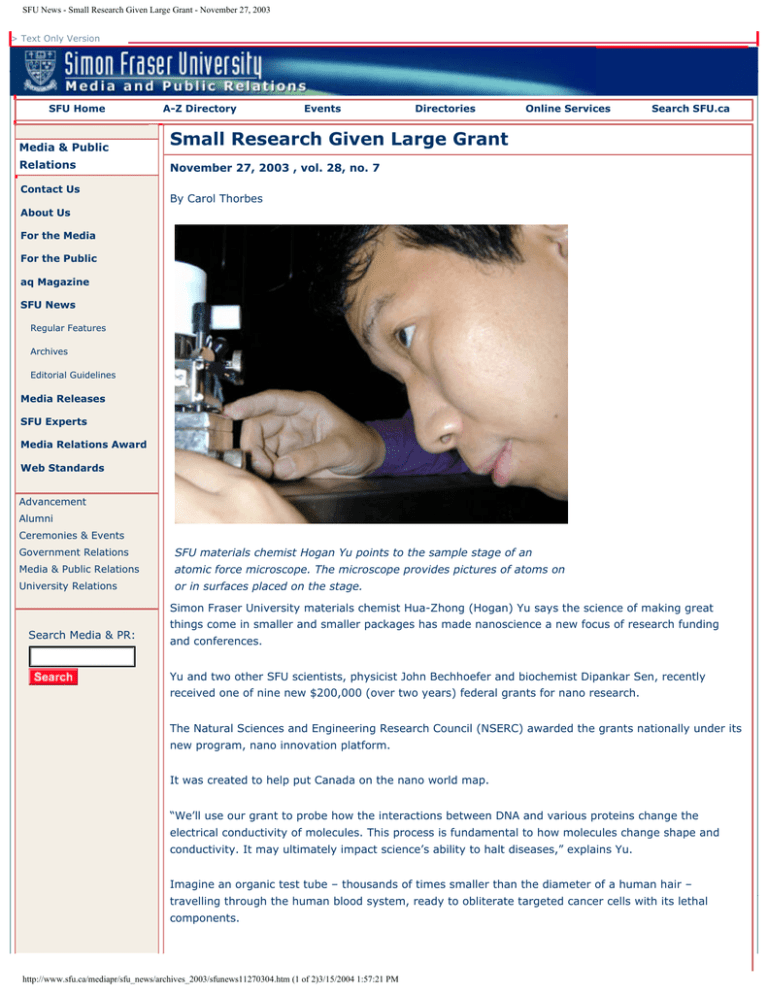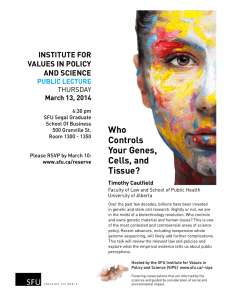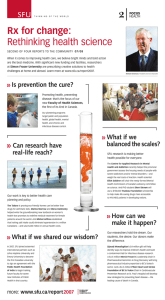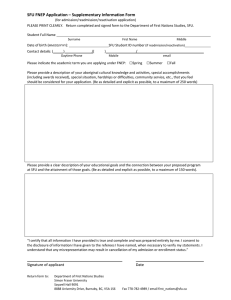
SFU News - Small Research Given Large Grant - November 27, 2003
> Text Only Version
SFU Home
A-Z Directory
Events
Directories
Media & Public
Small Research Given Large Grant
Relations
November 27, 2003 , vol. 28, no. 7
Contact Us
Online Services
Search SFU.ca
By Carol Thorbes
About Us
For the Media
For the Public
aq Magazine
SFU News
Regular Features
Archives
Editorial Guidelines
Media Releases
SFU Experts
Media Relations Award
Web Standards
Advancement
Alumni
Ceremonies & Events
Government Relations
SFU materials chemist Hogan Yu points to the sample stage of an
Media & Public Relations
atomic force microscope. The microscope provides pictures of atoms on
University Relations
or in surfaces placed on the stage.
Simon Fraser University materials chemist Hua-Zhong (Hogan) Yu says the science of making great
Search Media & PR:
things come in smaller and smaller packages has made nanoscience a new focus of research funding
and conferences.
Yu and two other SFU scientists, physicist John Bechhoefer and biochemist Dipankar Sen, recently
received one of nine new $200,000 (over two years) federal grants for nano research.
The Natural Sciences and Engineering Research Council (NSERC) awarded the grants nationally under its
new program, nano innovation platform.
It was created to help put Canada on the nano world map.
“We’ll use our grant to probe how the interactions between DNA and various proteins change the
electrical conductivity of molecules. This process is fundamental to how molecules change shape and
conductivity. It may ultimately impact science’s ability to halt diseases,” explains Yu.
Imagine an organic test tube – thousands of times smaller than the diameter of a human hair –
travelling through the human blood system, ready to obliterate targeted cancer cells with its lethal
components.
http://www.sfu.ca/mediapr/sfu_news/archives_2003/sfunews11270304.htm (1 of 2)3/15/2004 1:57:21 PM
SFU News - Small Research Given Large Grant - November 27, 2003
Welcome to the world of nanoscience.
The manipulation of atoms and molecules to develop nanometer sized (less than a billionth of a metre)
and larger structures with novel physical, chemical and biological features – was science fiction.
But, in the last decade, the use of newly developed tools for nanoscience, such as atomic force
microscopes, has led to gigantic leaps in physics, chemistry, materials science and other fields.
Yu points to carbon nanotubes, as strong as steel, but one sixth of the weight.
“Many of the extraordinary properties attributed to nanotubes have fed fantastic predictions of
microscopic robots, dent-resistant car bodies and earthquake resistant buildings,” explains Yu.
“The ability to change the composition and to manipulate the structure of materials, such as silicon, has
dramatically increased computer power.”
The former post-doctoral fellow of 1999 Nobel Prize winning chemist Ahmed Zewail is the organizer of
this year’s annual meeting of the Pacific Centre for Advanced Materials and Microstructures (PCAMM),
hosted by SFU.
For the first time, a key focus of the seven-year-old annual meeting will be nanoscience.
More than100 participants from SFU, UBC, the University of Victoria and local industries, working in
different disciplines, will discuss advanced materials and nanoscience issues.
“The posters and discussions coming out of this meeting will help advance commercialization of new
discoveries in nanoscience and engineering,” predicts Yu.
The free PCAMM meeting takes place on Dec. 6, from 9 a.m. to 5 p.m. at the Halpern centre on the
Burnaby campus.
Yu is accepting electronic submissions of proposed conference presentations until Dec. 2. Contact Yu at
604-291-5601 or hzyu@sfu.ca
>>back to SFU News
Printer-Friendy Version
Terms & Conditions
Copyright © 2003. Simon Fraser University. All Rights Reserved.
Questions and comments contact erwebmaster@sfu.ca
http://www.sfu.ca/mediapr/sfu_news/archives_2003/sfunews11270304.htm (2 of 2)3/15/2004 1:57:21 PM






